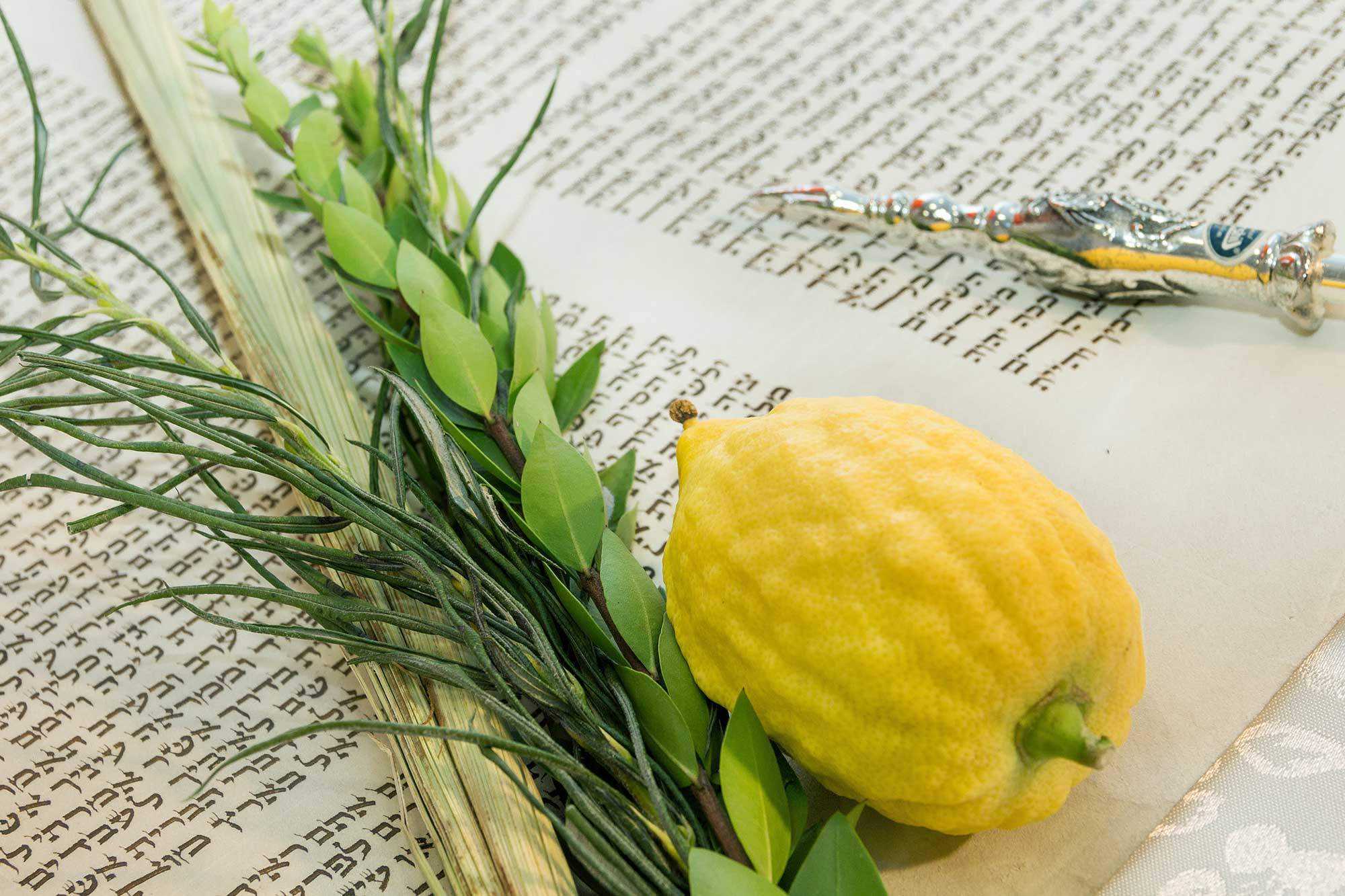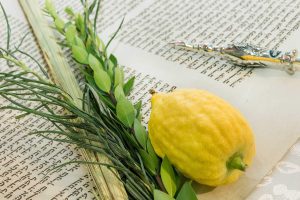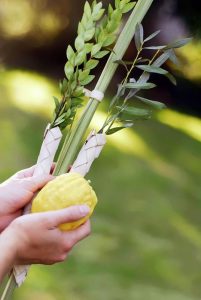Death by Flying Esrogim:
Can fruit kill? Is the esrog, the fruit we use over Sukkis, deadly? Can the esrog (citron) fly? We shall examine these questions below, ober we begin here. As discussed over the past nine years –we are in year ten mamish- the RBSO, in His heylige Toirah which He gifted to the Yiddin as part of their nuptials, was good enough to include 613 mitzvos. Over the generations many Toirah inspired Yiddin figured out that these mitzvis –in addition to significant spirituality they represent, also meant one more thing: money! They read the words of the heylige Toirah carefully and shoin: many an industry was born. Hundreds of Toirah inspired entrepreneurs have, over the generations, figured out how to make a living while helping others perform the mitzvis; mamish a win-win. So good have they become at their craft, they have found ways to convince us to buy products and services absolutely not mandated by the Toirah, and in many cases not even by our sages. Employing guerilla tactics, we are shamed, shammed, or guilted into purchasing products or services marketed under the guise of ‘mihadrin,’ ‘super glatt,’ ‘bodek,’ and others. The bottom line: good for them; they figured out the system; Jewish guilt sells.
Pesach (Passover) has become a multi-million dollar gisheft (industry) and with the price of matzo continuously on the rise while making sure the dough does not, prospects for future growth is virtually assured. Pesach injects a few hundred million into the economy, much of it into Jewish hands, geloibt der abisther (thank the RBSO). One might argue that the Sukkis is just behind, ober not by much. The Sukkis economy is strong, involves the Chinese where most sukkis are manufactured, as are many decorations and is avada the source of kimat all bamboo mats and poles. In fact, until recently, over 70% of all shiny and flimsy decorations came from China. How the Chinese became so entangled in our mitzvah observance, ver veyst? Ober the Yiddin love Chinese. And for the Yom Tov of Sukkis we also involve the Mitzrim (Egypt). The vast majority of our lulavim (palm fronds) are imported from a country which enslaved the Yiddin for over 210 years. Shoin: business is business and if the heylige Toirah commands us to take for ourselves a lulav during Sukkis, to Egypt our Toirah inspired entrepreneurs will travel and make arrangements. And if the German’s have been paying reparations for war crimes committed during WWII, avada it’s understood that we need to drive German made cars; how else can they afford to make payments without?
Speaking of taking lulavim –one each per person- in order to complete the requirement and perform the mitzvah as described in the heylige Toirah, we are also to bundle the lulav with hadasim and arovos (branches of myrtle and willow). Together with the esrog, we hold the completed set close to our hearts, make a brocho over them, shokel (wave) them when required, and shoin when all is said and done, we discard them like yesterday’s bad habits.
This past Sunday, on erev yom tov mamish, the Oisvorfer was out and about –just after shul- looking to purchase several sets of lulovim and esrogim. So happens that this year’s esrogim were quite fine, each vendor visited has a nice selection. Within minutes mamish, three esrogim were selected as were the lulavim and adorning branches. The vendors –two young boys, each no more than 16- packed up the esrogim, lulavim, woven baskets, hadasim, arovis, as well as a few extra rings to help tie them all together, and off the Oisvorfer went. Ober when it came time to assemble the sets, a shtikel panic set in: while I was sure that I set three of each –hadasim and arovios to the side, during assembly it was discovered that only two sets of hadasim made their way home. A third went missing. Efsher one climbed out of the bag and enjoyed Sukkis in the car? An attempted peek thru the tinted windows did not reveal them. Efsher the eishes chayil threw them out- she loves throwing things out! She did admit to throwing out the bag but denied that it contained hadasim. Nu, go start a fight over missing hadasim. In any event, it was time to light candles and go to shul. The story continues: Because the in-laws were over and because the walk is a bit shorter, on yom tov morning the Oisvorfer decided to daven at Beth Sholom. There he sat next to, and in the seat marked “Shlomo Gottesman” – he was good enough to slide over one seat- to whom he recounted his missing hadasim woes. Said Shlomo: “grada I have an extra set.” Givaldig! By day two the Oisvorfer’s last set was completed. As it turns out, the laws on day two aren’t as strict as they are on day one of the chag (festival) as we will find out just below; stay tuned for an amazing chiddish (breakthrough).
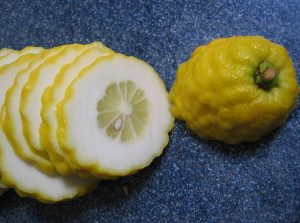 And while we guard the esrog with our lives making sure its properly handled and housed so that its pitim is secure –no one wants to explain how and why his pitim became dislodged, in his short speech, the rabbi retold a myseh from the heylige Gemora (Sukkah 36:a-b) about a Rebbe Chanina who had the habit of biting into his esrog –on yom tov mamish- and then making the required blessing before shokeling (waving) his lulav/esrog combo in six directions. That story for another day. The bottom line: according to Jewish law as codified, one may seemingly –after day one- take a bite out of his esrog and still use it to fulfill the mitzvah of lulav. Want more: learn the heylige Gemora, it’s chock full of interesting sukkah/lulav/esrog adventures. And listen to this:
And while we guard the esrog with our lives making sure its properly handled and housed so that its pitim is secure –no one wants to explain how and why his pitim became dislodged, in his short speech, the rabbi retold a myseh from the heylige Gemora (Sukkah 36:a-b) about a Rebbe Chanina who had the habit of biting into his esrog –on yom tov mamish- and then making the required blessing before shokeling (waving) his lulav/esrog combo in six directions. That story for another day. The bottom line: according to Jewish law as codified, one may seemingly –after day one- take a bite out of his esrog and still use it to fulfill the mitzvah of lulav. Want more: learn the heylige Gemora, it’s chock full of interesting sukkah/lulav/esrog adventures. And listen to this:
Speaking of biting one’s esrog, some say it’s a “segulah” (folk remedy, safeguard, superstitious action, talisman, etc), while others discuss it as a minhag (custom), for a pregnant woman to bite off the pitum of the esrog on Hoishana Rabbah. A sigulah for what? They say it’s associated with easy labor. Ober how is the biting of the esrog at all related to childbirth? What’s pshat? Some years back, an email titled Halocho For Today (Wednesday, 21 Tishrei 5772 (October 19, 2011) stated azoy: It is a segulah for pregnant women to bite off the pitum of the esrog on Hoishana Rabbah, to give Tzedoko, and to daven for an easy labor. A joke? Not! Several sources including the Likutei Maharich (Sukkos 106a), the Elef Hamagen (Siman 660:6), and Sefer Moed L’Kol Chai (24:25) provide a special text to be recited by the pregnant woman.
Others say the esrog should not be eaten on Hoishana Rabbah, given that it’s a special Yom tov day and that the esrog is muktzeh (after davening). Ober what should the hungry pregnant woman do? What if she davka wants a bite out of something fleshy looking, say it’s not so? Not to worry: she should wait one more day and enjoy her bite on Shmini Atzeres. Ober that’s only in the land of Israel. What to do if a women living outside the Land wants a bite on Shmini Atzeres? She should wait until Simchas Toirah when anything goes. Yes, there is a source for that as well.
The bottom line when it comes to biting and eating of the esrog –with or without jelly- is azoy: says the Taamei Minhogim (pg 521 paragraph 68), azoy: There is a custom for women to bite off the pitum of the esrog. The reason? Our sages suggest that (according to one opinion), the forbidden fruit Odom and Chava ate over in Gan Eden was an esrog. Shoin! The original sin is back to haunt us. By biting off the pitim, she is demonstrating that “just as I have no benefit/pleasure from biting a pitum, so too I had no benefit/pleasure from the sin.” Says the Kaf HaChaim (664:60): there is a minhag to take the esrog used over Sukkis, and turn it into Esrog Jelly, to be eaten on Tu B’Shevat (the 15th of the month). And, there is a minhag for pregnant women to eat esrog jelly while in labor, as a “segulah” for easy labor, and children that grow up with a good and peaceful life. The bottom line: women don’t necessarily derive pleasure from biting into the fleshy esrog. Veyter.
 Ober this year, we’re going to learn a shtikel Gemora which recounts how on Sukkis, and notwithstanding the price paid for esrogim, people used them as weapons, as projectiles mamish, and caused harm and damage. Mamish? Says the heylige Gemora (Sukkah 48B), azoy:
Ober this year, we’re going to learn a shtikel Gemora which recounts how on Sukkis, and notwithstanding the price paid for esrogim, people used them as weapons, as projectiles mamish, and caused harm and damage. Mamish? Says the heylige Gemora (Sukkah 48B), azoy:
“תנו רבנן, מעשה בצדוקי אחד(! ) שנסך על גבי רגליו ורגמוהו כל העם באתרוגיהן ואותו היום נפגמה קרן המזבח והביאו בול של מלח וסתמוהו וכו'” (סוכה, מח’ ב’).
The heylige Gemora describes a Kohen Gadol (High Priest) who openly mocked the mitzvah of “nisuch hamayim” (water libations), by pouring water from the designated golden pitcher onto his feet rather than on the altar. The incensed crowd (who evidently were composed mostly of Perushim) began pelting him with their esrogim and on that day a corner of the mizbayach (altar) was damaged and required repair.
The heylige Gemora says what? The Kohen (Priest) did what? What is ‘nisuch hamayim’? Who were the Perushim? And are we to believe that Yiddin, having inspected their esrogim for hours before selecting the perfect one to show off in shul, took them and threw them at the koihen? What’s taka pshat here? What went down? Just what did the koihen do to so offend the Yiddin? Moreover, could the esrog –which looks like a lemon with acne- be so potent so as to cause damage to the mizbayach which was fashioned of solid materials? Could the esrog damage the metal? Is this shtikel Gemora emes?
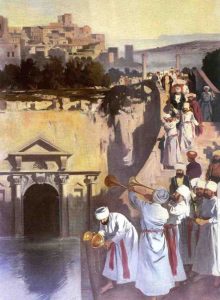 Ober to chap what took place, we need to open one or more windows and introduce the mitzvah –not found anywhere in the heylige Toirah, yet followed as if it were given to Moishe while he was up on Har Sinai (a Mosaic tradition). What mitzvah is that? It’s none other than the mitzvah of water libations, the commandment to gather water which was to be poured onto the altar. Water spilling is a mitzvah? Shoin, I can tell that most of you are confused and who can blame you? Let’s start again: The commandment of water libations is indeed never explicitly mentioned in the heylige Toirah. Ober, our sages of yore, relying on several verses found elsewhere, decided that this mitzvah is to be considered as “Halocho L’moishe MiSinai” (as if it were written in the heylige Toirah itself). And they decided this how and why?
Ober to chap what took place, we need to open one or more windows and introduce the mitzvah –not found anywhere in the heylige Toirah, yet followed as if it were given to Moishe while he was up on Har Sinai (a Mosaic tradition). What mitzvah is that? It’s none other than the mitzvah of water libations, the commandment to gather water which was to be poured onto the altar. Water spilling is a mitzvah? Shoin, I can tell that most of you are confused and who can blame you? Let’s start again: The commandment of water libations is indeed never explicitly mentioned in the heylige Toirah. Ober, our sages of yore, relying on several verses found elsewhere, decided that this mitzvah is to be considered as “Halocho L’moishe MiSinai” (as if it were written in the heylige Toirah itself). And they decided this how and why?
In any event, this particular mitzvah became a lightening rod between the Tzidukim (Sadducees) and the Perushim (Pharisees). As an aside, the Seduces believe only, and observe only those mitzvis written in the heylige Toirah, as opposed to the Perushim who are ardent followers of the heylige Toirah, Mishneh and Gemorah. To make a long story short, over Sukkis, as the Yiddin were performing the water libation ceremony, one koihen -seemingly a closeted Sadducee sympathizer- came out. Instead of following the mitzvah which calls for water to be offered on the altar (in addition to wine), he decided that the ceremony was foolish. Instead of pouring water gathered the evening before onto the altar, he spilled the water onto his feet. Shoin: this brazen act of defiance –bifrahesya- (openly in public view) led to the outright violence described in the heylige Gemora. As an aside: the RBSO may look aside if you sin privately, but He abhors mamish sinning in public. Avada you recall how Zimri and Kozbi got the point following lewd sex acts in public view. The bottom line: if you want to be a micutzif (wisenheimer) to the RBSO, do it behind drawn binds.
What is “nisuch hamayim” and the ceremony known as “simchas beis hashoieyvo?” And in English: what are water libations and the water drawing ceremony? Let’s find out. Each morning of the festival, during the daily sacrifice, water was poured onto the altar in a special manner. Daily except for shabbis of course when the water to be used was prepared on Friday. What was special about this water? Back to libations: daily the kohanim descended down to the Shiloiach, accompanied by all the congregation assembled in the Temple. What is the Shiloiach? At the foothills of Mount Moriah, down below in the City of David, flows a natural spring called Shiloach. This spring is ancient, and is located literally in the shadow of the Holy Temple. It has always had spiritual significance for the Yiddin. It is the original source of Jerusalem’s water. There, they filled a golden flask with 3 lug (about 1/2 liter) of the pure water. Ascending back up, carrying the flask with song and elating with that singular feeling that comes only from fulfilling the RBSO’s will, the gathering entered back into the Temple through the Water Gate, one of the gates on the southern side of the court. As they entered the gate, their steps were greeted by the sound of trumpets and shofar-blasts, in fulfillment of the prophet Isaiah’s words (12:3) “With joy you shall draw water out of the wells of salvation.” Once in the Temple, the kohain who had the honor of performing this service carried the golden flask up the altar ramp. At the top, he turned to his left. Since the ramp is located at the south side of the altar, this means that the Koihen faced the southwest corner; it is here that the libations were poured. Here at this corner, two silver cups were fixed on the top of the altar, sitting next to each other. The one further east received the wine libations that are poured out every day at the time of the daily tamid sacrifice; the other was designated for this service, which took place on exclusively during the chag of Sukkis. Got all that? Veyter!

A very nice story ober what is the connection to flying esroigim, damage to the mizbayach and a rouge koihen? Let’s find out. As we avada all know –some from various TV shows put on by the goyim, and others from learning in yeshiva- that during the era of the Second Beis Hamikdash (Temple) a sect called the Sadducees had substantial influence in society. The platform of this cult was based on denial of all aspects of the Oral Tradition. In the heylige Gemora they did not believe, nor in the Mishneh, say it’s not so please. And it so happens that the mitzvah of the water libation, was handed down orally as halacha LiMioshe mi’sinai (Mosaic tradition), and is the classic example of an Oral Tradition. Ober the Sadducees, who denied that there was any such requirement on Sukkis, vehemently opposed it. The observant Yiddin, mamish to demonstrate their faith in the RBSO and in the authenticity and validity of Mosaic traditions, executed this ceremony on a grand scale and in the public eye.
Ober, says the Gemora azoy: on at least one occasion, the water was not poured into its proper cup at all. Instead, the officiating priest poured the libation onto his own foot! Those present in the Holy Temple immediately understood, and reacted as one man: “the entire congregation stoned him with their esrogim.” What happened next? We’ll get to that shortly.
Shoin, we can chap how in a fit of anger they pelted the traitor with esrogim, ober shtlet zich di kasha (the question arises): how did these citrons cause damage to the mizbayach? And what happened to the pelted koihen? Did he survive the esrog onslaught? Ober says Rashi azoy: the Yiddin were taka pissed off and mad as hell. Not only did they throw their esrogim at the wayward kohain, they also threw rocks. Says the Aruch L’ner azoy: first the crowd threw their esrogim and when they were done with that, they picked up rocks and began throwing them in the direction of the Koihen who was still standing on the altar. Death by esrog! They killed him! Does everyone agree? Of course not: others claim that he was not esroged to death, more on that below.
What happened next? To prevent esrogim hurling and rock throwing, our sages –called an emergency meeting and instituted new protocols for the performance of this mitzvah. Says the heylige Gemora (Sukkah 97), azoy: from then on, the Kohen was supposed to raise his hands high–in order to provide the crowd with a good view–while performing the libation.
The bottom line: says the heylige Gemora azoy: “He who has not seen the Water-Drawing Celebration has never seen joy in his life.” And as to why the kohen was killed instead of receiving lashes which is the typical punishment for improper temple service, an answer I once heard suggests azoy: Heretics, informers, and sinners anger the RBSO: we kill them and do not save them. The Sadducee Koihen certainly qualified as a heretic and permission was therefore seemingly granted for his pelting with esrogim or esrogim plus rocks. And the rocks seemingly also caused structural damage to the altar. Gishmak. Ober what about today here in golus? Are water libations still being practiced? In keeping with the Toirah’s directive of being happy (You shall rejoice on your holiday), many orthodox shuls around the world, the absence of the Temple notwithstanding, continue to celebrate the tradition with music and dancing during the nights of Sukkis. Speaking of dancing, the mingling of the sexes during these celebrations –as further described in the heylige Gemora (Sukkah 52) is what gave birth to a women’s balcony in many shuls. We will cover that episode and topic next year.
Chag somayach and a gittin Shabbis-
The Heylige Oisvorfer Ruv
Yitz Grossman
